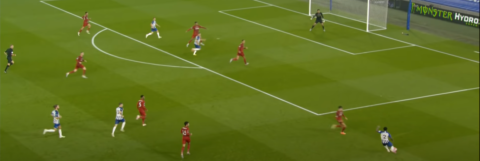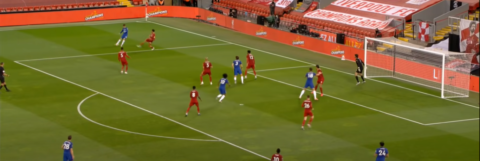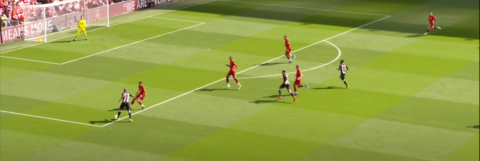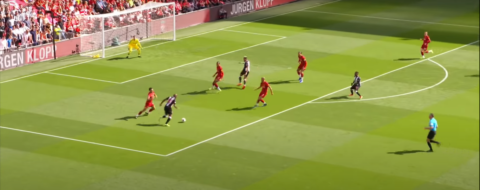Over the last two seasons, Liverpool have been remarkably good. As it stands, they are one of the two best teams in the world alongside Bayern Munich, who recently unseated them on the European throne.
But Jurgen Klopp’s Reds are not perfect. And this season they become the hunted after relishing the status of hunter.
And so, ahead of an anticipated onslaught from the rivals determined to take their title, I’ve considered the areas of weakness at Anfield.
I’ve broken it down into three simple sections: the first two examine how you score against Liverpool and how you stop them scoring. And the third returns to the now age-old questions surrounding squad depth.
How do you score against Liverpool?
Last season, Liverpool conceded 33 goals – a full 11 more than they shipped as runners-up in 2018/19 but still the fewest in the division.
I watched those 33 goals back in search of patterns, and three emerged, albeit on a necessarily limited scale.
Two of these weaknesses are certainly not unique to Liverpool, and are both consequences of their style of play. That should be stressed. Tactical decisions are about risk and reward. But they are still worthy of our attention, because they could feasibly decide games.
You won’t be surprised to learn that the first pattern is Liverpool’s vulnerability to the counterattack. When you consider how many bodies Liverpool commit forward, they actually coped with this threat surprisingly well by and large.
But there were still a few goals created following turnovers from the spaces vacated by our attacking full-backs.
The first example is the most plain. In the first half of the draw against Manchester United in September, Andrew Robertson fizzes a pass into Divock Origi. As Origi goes to ground under challenge from Victor Lindelof, Robertson is bombing on in anticipation of the return ball.

After United controversially wrestle back possession (sometimes it takes a foul to catch Liverpool out), Daniel James is unleashed down Robertson’s side, with Gini Wijnaldum and Virgil van Dijk unable to close him down before he whips in a cross that Marcus Rashford converts.

The second example comes from the 2-1 victory against Bournemouth in the final Premier League game before the season was suspended. This time it’s stand-in left-back James Milner getting caught too high, leaving Jefferson Lerma unchallenged to tee-up Callum Wilson. The Reds had had to scurry back into shape after Wilson was set running against Joe Gomez and shoved the defender off the ball.

And finally, we have the eight-goal thriller at home to Chelsea which preceded Liverpool’s coronation.
Chelsea’s second goal, which reignited the contest, owed itself to the genius of Christian Pulisic, who effortlessly weaved his way through four challenges to get into the Liverpool box. And yet, it may still have been prevented had Robertson been stationed in front of Tammy Abraham. He was hurtling back in vain.

The next vulnerability identified is more interesting. Broadly speaking, Liverpool mark zones rather than men when they are defending and, again, this probably prevents more goals than it causes, as it must to remain viable. But it does mean that attacking players can find joy by standing off.
Think back to the massive win against Manchester City. Bernardo Silva’s second-half strike was a mere consolation, but it comes from clever positioning.
As Angelino shapes to drive the ball across the box, Silva hangs back, perhaps about seven yards behind Robertson. When the ball reaches him, he is able to precisely steer it home. He knows he only has one touch before being closed down, and he makes the most of it. Quality attacking players are ruthless.

This repeats itself against West Ham, albeit less obviously. The Hammers, remember, came from behind to grab the lead in this game and it was courtesy of Pablo Fornals.
Fornals takes a couple of glances at Gomez and Van Dijk before Rice delivers, and he stands his ground rather than attacking the front post. He then has time to apply a scuffed finish.

Onto the dead-rubber against Brighton and the Lucas Trossard goal which made it interesting. As Tariq Lamptey winds up his cross, Trossard, at the top of the picture, checks his run while Gomez retreats. The delivery is precise and, like Silva, he goes on to produce an excellent first-time finish, smashing the ball beyond Alisson.

The fourth and final example of this is from that aforementioned game against Chelsea. Van Dijk is marking the dangerous Giroud, who eventually scores. But look at Willian, almost at the centre of a zonal-marking star. After Alonso manages to get a flick-on from the Mount cross, Willian gets a shot away, and Giroud bundles in the rebound.

The third defensive weak-point is individual. We know that Trent Alexander-Arnold is reaching stratospheric levels as an attacking full-back, but it is true that there is room for improvement going the other way.
Trent has a tendency to show the wide-player inside, whether deliberately or through an awkward body-shape, and on a few occasions last season he was punished.
Jetro Willems’ opener when Newcastle visited Anfield was one of the finest goals of the season. It certainly owes more to the brilliance of the strike than it does the limited resistance.
Willems is admittedly left-footed, so you can completely understand Trent showing him onto his right.
But compare the two images. In the first, Trent appears to be in control of the situation. But a few seconds later, Willems has left him behind, opening up a clear angle to the right-hand side of the goal.


About a month and a half later, in the first minute of a home game against Spurs, he begins his duel with the deadly Heung-min Son. Liverpool are on the backfoot after Moussa Sissoko weaved through their midfield.

What’s striking here is that by the time Son drops his shoulder and charges up his shot, it’s Jordan Henderson tasked with stopping him, with Trent taken out of the equation altogether.
Son, who’s right-footed, is more than capable of inflicting damage from the position he’s now reached. He sees a shot deflected onto the crossbar, and Harry Kane gobbles up the seconds

Last of all, we return to the Chelsea game as Pulisic wreaks havoc.
As he controls this cross, Trent has a decision to make. Pulisic has his body in the way, so a tackle could easily lead to a penalty. Does he usher him right for the near-post finish, or left for the off-balance far-post shot?

He chooses right, but he approaches the American at such an angle that Pulisic finds ample room to rip a strike past Alisson.

Alexander-Arnold’s almost timid approach can be remedied. The other two ‘weaknesses’ are best seen as the cost of particular stylistic choices. They’re small issues which rarely crop up.
Note also the absence of ‘balls in-behind the high-line’ from this discussion. That’s because we shouldn’t see it as one of our frailties. It’s actually integral to our pressing game, compressing the pitch and suffocating the opposition. The benefits – and this point could be extended across the whole section – are simply less tangible than the drawbacks.
Liverpool won all but one of the games recalled above, and that leads us into our next section. For the opposition’s exploitative attacking tactics to pay off, they also need to keep Liverpool out, an even more daunting proposition.
How do you stop Liverpool scoring?
Is the answer to this question as deceptively simple as ‘neutralise the full-backs’, Liverpool’s assist machines?
The reason the much-maligned, perceived absence of a ‘creative’ midfielder has had little adverse effect is that Alexander-Arnold and Robertson provide immensely effective supply lines.
They provide the width and stretch the opposition block as the ‘wingers’ predominantly move inside.
Last season, Trent created 18 ‘big chances’ (generally one-on-one situations or close range, low-pressure opportunities) from his station near the right touchline and averaged 2.3 key passes (balls leading to an attempt on goal) per match.
Robertson can’t quite match that but his figures remain mighty – 14 big chances created and 1.7 key passes per game.
So is Liverpool’s reliance on the world-class duo excessive?
Among his midfielders, Klopp prizes athleticism and pressing aptitude above creation. Neither Georginio Wijnaldum nor Alex Oxlade-Chamberlain, in spite of his greater attacking licence, fashioned a big chance last season. The deep-lying Fabinho could only pitch in with four.
But Liverpool have profited from more central routes to goal in recent times.
Roberto Firmino finds joy when he drops off. Last season, he conjured up 10 big chances and provided eight assists.
Jordan Henderson’s attacking contribution also goes underappreciated. Only Trent made more passes into the final third per 90 minutes in 2019/20.
And Naby Keita might be regarded as the joker in the pack. His stats for dangerous passing are actually similar to Henderson’s, but what makes Keita unique is the impetus he provides through dribbling and through his increasingly telepathic link-up play with Sadio Mane.
Keita will be crucial in establishing a multifaceted attacking threat if, and it’s a big if, he stays fit.
Since joining Liverpool in 2018, he has suffered four muscular injuries, two of which kept him out of action for around 10 weeks last season. His body remains a concern.
Liverpool are not as one-dimensional as you may be led to believe. However, their full-backs are indisputably vital to their potency as an offensive unit with limited, unpredictable contribution from midfield.
The addition of Kostas Tsimikas means opponents are less likely to profit from injuries, though Alexander-Arnold’s present deputy Neco Williams remains very raw.
When both are fit, how might an opponent thwart Alexander-Arnold and Robertson?
In recent times, Diego Simeone and Carlo Ancelotti (as Napoli manager) have given us some clue. As explained here by Premier League Panel, their 4-4-2 formations deployed the wide midfielders as constant trackers, and in Madrid and Naples, it worked.
For virtually every manager facing Liverpool this season, devising such a counter-strategy will be the top priority.
Last season, they were faced with a similar conundrum, and their solutions failed almost relentlessly. But can Liverpool keep expecting joy? The innovations of Klopp and his adversaries will be fascinating.
There may be some supporters anxious about the number of strings to their side’s bow.
Is Liverpool’s squad big enough?
The warnings remain much the same: ‘if x is injured long-term, it could cost Liverpool the title’.
I’ve actually written before about the encouraging injury histories of Alexander-Arnold, Van Dijk, Firmino, Mane and Mohamed Salah and suggested that their availability, their naturally-reduced susceptibility to serious injuries, is an underrated attribute. There is growing evidence showing that, just as some players are injury-prone, many others tend to be injury-resistant.
Of course, any player can fall victim to circumstance, and the risk of muscular problems has certainly heightened with the compressed, even more breathless schedule.
But for me the risk of performance-sapping fatigue should be a greater concern than the risk of injury. Jurgen Klopp prefers smaller, closer-knit squads but 2020 calls for compromise.
Between the start of the season and New Year’s Eve – a period of 17 weeks – Liverpool will play at least 23 and up to 26 times depending on Carabao Cup progression. And there will be two more international breaks in that time where the entire starting XI could conceivably be called upon.
Theoretically, there may be 10 games scheduled for December alone.
Liverpool have rotation options at full-back, in midfield and, with Takumi Minamino and (hopefully) Rhian Brewster, at centre forward. But Joel Matip is the sole senior centre-half who can be used as a rotation option. Only absolute necessity would shift Fabinho backwards.
More significant is the burden to be placed upon principal match-winners Salah and Mane given the inadequacy of the alternatives. Divock Origi was poor last season, Alex Oxlade-Chamberlain tends to have little impact at right-wing and Xherdan Shaqiri’s fitness problems show no signs of letting up. Harry Wilson, meanwhile, seemingly hasn’t earned Klopp’s trust.
Liverpool are light on dependable options in some departments partly because of their financial model, because of their insistence on spending only the funds generated by as-yet unarranged outgoings.
They may have made a mistake by admitting their weakness through their jurnalistic contacts. Yes, it has suitably tempered the expectations of some supporters, but it has also weakened their negotiating position. Why would clubs stoke up the reported £20million asking prices for Wilson or Marko Grujic, when they could instead demand a compromise in the knowledge that Liverpool may have to blink first if they are to secure targets like Thiago Alcantara and Ismaila Sarr.
I think and hope Liverpool will find a way to finance those moves. They would go some way to addressing the second and third ‘weaknesses’ respectively. But, as it stands, they nag the back of the mind.
Equally, at this present moment, I expect the Reds to retain their title, because their competitors’ weaknesses are graver – City lack the mental fortitude, while Chelsea and United lack the maturity.
And it’s hard to believe, but this already-legendary team can find ways to grow stronger.





Klopp & Co might aim for 100 + points in 20/21. As unpopular as it sounds, why underestimate Klopp? If Gini stays he can add to his assist and goals #. Bobby is bound to upgrade his scoring production. Naby can emerge into a mega star, Taki can add more creativity. Not to mention, Ali might stay healthy to play most of the season and motivated to go for the clean sheet. Pep and Klopp are thinking a step ahead, EPL competitors beware.